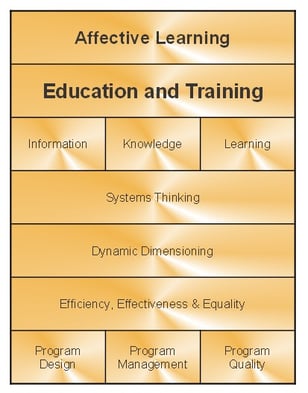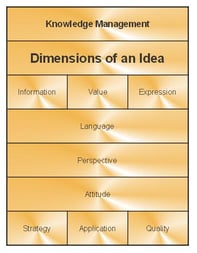Published on
Measuring and Managing Education and Training

The nuts and bolts of innovation in education and training is essentially a job of rethinking the way we measure and manage knowledge. We need a collaborative knowledge management system to match our new collaborative information world. Social media such as LinkedIn, Wiki, etc. can inherently become major factors in educating and training if universal knowledge dimensioning (as described in previous articles on knowledge management and affective learning systems) is used.
The art of good management is good dimensioning. This applies to knowledge like everything else. There are three types of knowledge dimensioning.
Physical Dimensioning
The fundamental type is “physical dimensioning” which we use to measure the things we do in the physical world – time, distance, mass, etc.
Category Dimensioning
The second type is “category dimensioning” which we use to define the things and processes we want to physically measure. In the industrial world this takes the form of knowledge classification and is underpinned by the control of knowledge and sometimes monopolization. In education and training, it takes the form of courses that are artificially unique to the institutions that own them and sometimes to divisions within the same institution.
The third type is “focus dimensioning” which we use to manage affinities among category focuses. This takes the form of hierarchies that allows us to continuously see the bigger picture framework as we build knowledge systems.
As a simple example of dimensioning, we can use physical dimensioning to describe the function of kitchen appliances. We can use category dimensioning to describe the different types of kitchen appliances and we can use focus dimensioning to show how kitchen appliances fit into the bigger picture of all types of household appliances.
Information
We receive information and hold it in our working memory as long as we need to use it and then we move on to get more information and repeat the process. But we always remember what we do. We can recall information from our subconscious memory when we need it, but we do not know how this happens. We have no natural mechanism to know what we know as a comprehensive structure. So can we measure what we know?
Knowledge
The subconscious mind organizes ideas processed by the conscious mind. The previous articles in this series describe my theory of how this process works and how the subconscious mind organizes the knowledge that we possess. It provides a system for measuring what we know and how we know it. This system has practical value for managing education and training. If we can understand how we learn and how we remember, we can build much better education and training systems.
Learning
Dimensioning is the key. We can replace competitive learning methods and intelligence measurements with a system of measuring and monitoring the learning process and the building of knowledge. This will completely change the current focus of education and training from competitive to democratic where passing and failing is replaced with affective learning. There will still be competitiveness, but it won’t drive the system.
Systems Thinking
Focus dimensioning of knowledge and learning can be seen as systems thinking. It provides a structure which shows how all knowledge can be organized into affinity systems. It allows us to understand systematic learning processes and how we remember complex ideas.
Dynamic Dimensioning
As the things we try to measure get more and more complex, the nature of the measurements become less objective. This is especially true for focus dimensioning. We categorize experience and we develop hierarchies of category focusses to create dynamic knowledge systems. What we know is always being modified. Knowledge is not a static commodity that can be simply assessed. Its dimensions are continuously changing.
Efficiency, Effectiveness and Equality
Dimensioning will enable us to manage education and training more efficiently and effectively, and it will enable more people to be successful because teachers can use it to better understand how to influence learning.
Program Design
Dimensioning will enable greater efficiency and effectiveness in the design of education and training. Programs will be articulated and harmonized to reflect the actual structure and process of learning and remembering.
Program Management
Dimensioning provides tools for comprehensive management of education. We will be managing a system rather than the isolated pieces. We will see the affinities among the different types of education and the programs and courses in each type. Credit transfer and credit for experience will become a routine part of credit accumulation.
Program Quality
If we are going to get the most out of our education and training systems, then we need to know how to assess all the dimensions of learning and remembering. In a collaborative information world, competition based on artificial uniqueness will not exist. Competitiveness will depend solely on the true and transparent quality of what we do and the ability to recognize true innovation.
It is the information world now and collaboration is here. Censorship is dead. Social media and wikinomics are redefining the world. Never before has there been such a need to understand how we learn and remember knowledge. Collaborators are the new winners. It is not what “I think” anymore; it is what “we think” that will generate the future. We are all starting to realize how necessary (and sometimes painful) this transition is.




